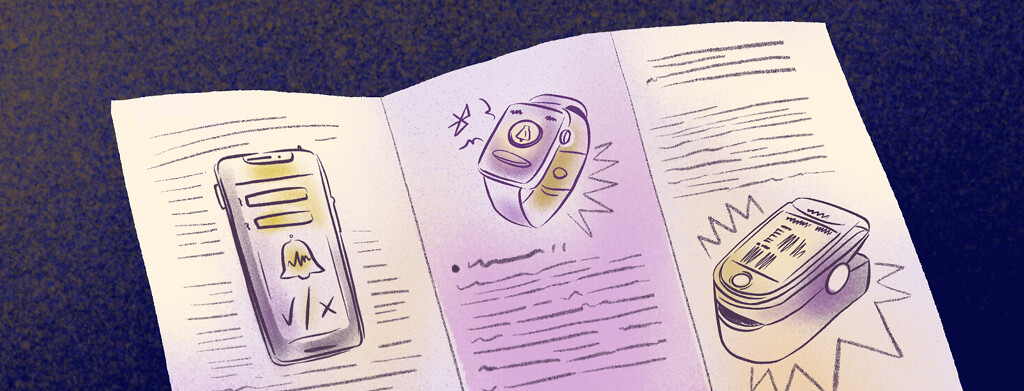The Latest in Wearable Electronic Devices for Seizure Tracking
Just like a FitBit or an Apple Watch can log how many steps you take each day, wearable electronic devices can track seizures and other neurologic symptoms. These devices can be helpful tools for people living with epilepsy in many ways, including:1
- Reducing risks
- Improving safety
- Monitoring signs
- Providing peace of mind
These devices cannot prevent seizures from happening. However, they can alert someone or their caregiver that they are having or about to have a seizure.
It is a helpful warning that can allow them to get to a safe place before their seizure starts. For instance, if they are in an environment where they could be injured, like driving a car. This level of protection can also bring people with epilepsy and their families a certain peace of mind.1
Why seizure tracking devices are helpful
In the past, doctors and medical teams relied on people and their families or caregivers to report an accurate log of a person’s seizures, including symptoms, how often seizures occur, and how long a seizure lasts. But data show that personal accounts are widely unreliable.1
Thanks to advanced wearable technology, this data can now be logged and saved in real-time. This provides doctors and researchers with more accurate information. More precise information allows for better treatment options and more precise medicine dosage.1
How seizure tracking devices work
Many seizure tracking devices work by monitoring a person's movement, heart rate, and blood oxygen levels. Suppose it detects any abnormal activity, such as shaking, trembling, or a sudden change in how a person walks. In that case, the device will send an alert to you, a family member, or a caregiver's smartphone so that help can be provided as soon as possible.2
These electronic devices can help detect tonic-clonic seizures (formerly known as grand mal seizures) because there are many convulsions during an episode.2
Types of seizure tracking devices
A variety of wearable electronic devices are available for those with epilepsy. Some of these include:2-4
Smartwatches – Several smartwatches have been developed to track unusual movement and electrical fluctuations in the skin that are sometimes associated with seizures. This data is then transmitted to a paired smartphone via a Bluetooth connection for easy monitoring. When detected, family members or caregivers are alerted. Some also come with a "help" button that users can push if they need assistance.
Mobile apps – Many apps monitor and detect seizure-like movements. Most are compatible with Samsung or Apple devices. Emergency contacts (previously programmed into the app) are notified by a call, text message, or email when a seizure is detected. Some apps may also offer help request buttons.
Pulse oximeters – These devices measure a person’s heart rate and blood oxygen levels by attaching to their finger or toe. While these do not detect or alert when a person has a seizure, they provide helpful information to help monitor seizure activity.
Seizure trackers – Often free to download, trackers allow you to log data about seizures, including how long a seizure lasts, their frequency, and medicine history. These personalized reports can then be shared with your medical care team to improve treatment options. It is important to note that these trackers do not detect and alert seizure activity. They are just a place to log information.
Cost and limitations
While these tech devices have come a long way, they cannot detect every type of seizure. For those with seizures that do not involve convulsions or big shaking movements, these devices may not be triggered.2,6
There is also the cost to consider. Some wearable devices can cost hundreds of dollars, and not all health insurances cover these costs.2,3
There are some organizations that may cover the costs or offer grants that you can apply for. Ask your doctor or healthcare team for more information or resources.3
Picking a wearable device that is right for you
Not all devices are the same, and everyone's medical situation is unique. Here are some questions to consider when choosing a device:2,4,5
- Can the device detect the type of seizure(s) you want to monitor?6
- What are your goals for tracking? For example, is your goal to log how often seizures occur? Or, do you want to be alerted when someone else, such as your child, has a seizure so you can help?
- Is it comfortable to wear?
- How is the device powered?
- Is it easy to use?
- How much does it cost?
- Is the device approved by the U.S. Food and Drug Administration (FDA) or going through an FDA-approval process?
- How does the device store data, and is the information stored securely?
Researchers are fine-tuning and advancing this technology every day. If no current device works for you now, there may be one down the road. Work with your doctor to determine which wearable device may be right for you.

Join the conversation